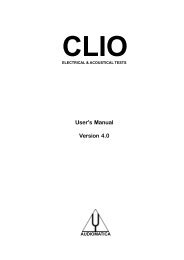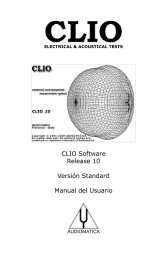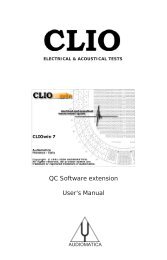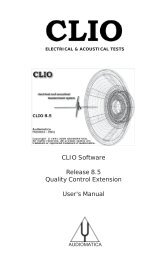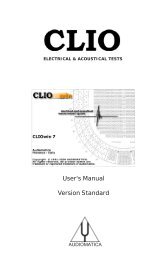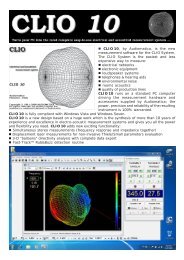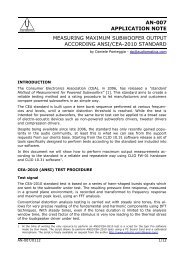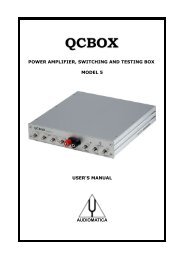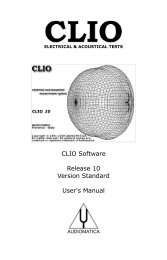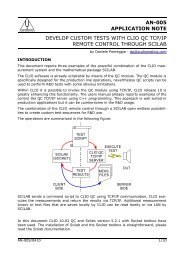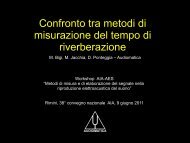CLIOwin 6.5 PCI User's Manual - Audiomatica Srl
CLIOwin 6.5 PCI User's Manual - Audiomatica Srl
CLIOwin 6.5 PCI User's Manual - Audiomatica Srl
Create successful ePaper yourself
Turn your PDF publications into a flip-book with our unique Google optimized e-Paper software.
value and the marker reading at 1kHz. Example: known resistor value 10 Ohm, reading<br />
at 1kHz 9.3 ohm, I sense value 0.127 Ohm. Multiply 0.127 by 1.075268817, obtain<br />
0.13655914, input this new value and check everything performing a new measurement.<br />
13.5 CONSTANT VOLTAGE & CONSTANT CURRENT<br />
These were the standard approaches to measure impedance with traditional set of<br />
instruments. We will skip further theoretical discussion and go directly on how CLIO<br />
implements them. These methods both require two external components, a reference<br />
resistor of suitable and know value (where known means better than 1% tolerance) and<br />
a power amplifier. They also require two measures to be taken one after the other,<br />
changing connections in between. CLIO, by means of its processing tools can speed up<br />
things a lot but the whole procedure remains quite complicate. Whatever you are going<br />
to use MLS or Sinusoidal, all the measurement should be performed in Volts (the Y Scale<br />
should be dBV).<br />
13.5.1 CONSTANT VOLTAGE<br />
Proceeding step by step we are going to create two files, one named “reference”, the<br />
second named “device”. The two measurement files must have identical settings and<br />
identical CLIO’s output level. We choose a sensing resistor, Rs, of 1 ohm 1%. Fig.13.11<br />
shows connections for creating the reference file. The level you choose now is the total<br />
measuring level.<br />
INPUT A<br />
CLIO<br />
INPUT B<br />
OUTPUT A<br />
OUTPUT B<br />
RS<br />
BLACK<br />
RED<br />
POWER AMPLIFIER<br />
Figure 13.11<br />
The reference measurement is shown in Fig 13.12. As expected the output of the<br />
amplifier appears as a straight line. Should not be so, this would not be a problem as<br />
the whole procedure compensate for any deviation in the frequency response. More<br />
interesting is the absolute level. As Rs value is small, this level appears nearly<br />
unchanged to the speaker. We read -12dBV that translate in 250mV.<br />
0.0<br />
CLIO<br />
180.0<br />
dBV<br />
Deg<br />
-10.0 108.0<br />
-20.0 36.0<br />
-30.0 -36.0<br />
-40.0 -108.0<br />
-50.0 -180.0<br />
10 Hz<br />
100 1k 10k 20k<br />
Chapter 13 - Measuring impedance and T&S parameters 133



